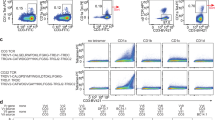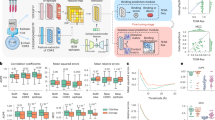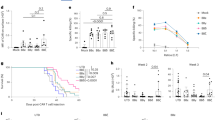Abstract
T-cell receptor-CD3 complex (TCR) is a versatile signaling machine that can initiate antigen-specific immune responses based on various biochemical changes of CD3 cytoplasmic domains, but the underlying structural basis remains elusive. Here we developed biophysical approaches to study the conformational dynamics of CD3ε cytoplasmic domain (CD3εCD). At the single-molecule level, we found that CD3εCD could have multiple conformational states with different openness of three functional motifs, i.e., ITAM, BRS and PRS. These conformations were generated because different regions of CD3εCD had heterogeneous lipid-binding properties and therefore had heterogeneous dynamics. Live-cell imaging experiments demonstrated that different antigen stimulations could stabilize CD3εCD at different conformations. Lipid-dependent conformational dynamics thus provide structural basis for the versatile signaling property of TCR.
Similar content being viewed by others
Log in or create a free account to read this content
Gain free access to this article, as well as selected content from this journal and more on nature.com
or
References
Birnbaum ME, Mendoza JL, Sethi DK, et al. Deconstructing the peptide-MHC specificity of T cell recognition. Cell 2014; 157:1073–1087.
Liu B, Chen W, Evavold BD, Zhu C . Accumulation of dynamic catch bonds between TCR and agonist peptide-MHC triggers T cell signaling. Cell 2014; 157:357–368.
O'Donoghue GP, Pielak RM, Smoligovets AA, Lin JJ, Groves JT . Direct single molecule measurement of TCR triggering by agonist pMHC in living primary T cells. Elife 2013; 2:e00778.
Huang J, Brameshuber M, Zeng X, et al. A single peptide-major histocompatibility complex ligand triggers digital cytokine secretion in CD4(+) T cells. Immunity 2013; 39:846–857.
Huang J, Zarnitsyna VI, Liu B, et al. The kinetics of two-dimensional TCR and pMHC interactions determine T-cell responsiveness. Nature 2010; 464:932–936.
Huppa JB, Axmann M, Mortelmaier MA, et al. TCR-peptide-MHC interactions in situ show accelerated kinetics and increased affinity. Nature 2010; 463:963–967.
Malissen B, Bongrand P . Early T cell activation: integrating biochemical, structural, and biophysical cues. Annu Rev Immunol 2015; 33:539–561.
Chakraborty AK, Weiss A . Insights into the initiation of TCR signaling. Nat Immunol 2014; 15:798–807.
Fazilleau N, McHeyzer-Williams LJ, Rosen H, McHeyzer-Williams MG . The function of follicular helper T cells is regulated by the strength of T cell antigen receptor binding. Nat Immunol 2009; 10:375–384.
Kim C, Wilson T, Fischer KF, Williams MA . Sustained interactions between T cell receptors and antigens promote the differentiation of CD4(+) memory T cells. Immunity 2013; 39:508–520.
Tubo NJ, Pagan AJ, Taylor JJ, et al. Single naive CD4+ T cells from a diverse repertoire produce different effector cell types during infection. Cell 2013; 153:785–796.
Winstead CJ, Weaver CT . Dwelling on T cell fate decisions. Cell 2013; 153:739–741.
Yamane H, Paul WE . Early signaling events that underlie fate decisions of naive CD4(+) T cells toward distinct T-helper cell subsets. Immunol Rev 2013; 252:12–23.
King CG, Koehli S, Hausmann B, Schmaler M, Zehn D, Palmer E . T cell affinity regulates asymmetric division, effector cell differentiation, and tissue pathology. Immunity 2012; 37:709–720.
Wucherpfennig KW, Gagnon E, Call MJ, Huseby ES, Call ME . Structural biology of the T-cell receptor: insights into receptor assembly, ligand recognition, and initiation of signaling. Cold Spring Harb Perspect Biol 2010; 2:a005140.
Morris GP, Allen PM . How the TCR balances sensitivity and specificity for the recognition of self and pathogens. Nat Immunol 2012; 13:121–128.
Aivazian D, Stern LJ . Phosphorylation of T cell receptor ζ is regulated by a lipid dependent folding transition. Nat Struct Biol 2000; 7:1023–1026.
Martinez-Martin N, Risueno RM, Morreale A, et al. Cooperativity between T cell receptor complexes revealed by conformational mutants of CD3ε. Sci Signal 2009; 2:ra43.
Blanco R, Borroto A, Schamel W, Pereira P, Alarcon B . Conformational changes in the T cell receptor differentially determine T cell subset development in mice. Sci Signal 2014; 7:ra115.
Mingueneau M, Sansoni A, Gregoire C, et al. The proline-rich sequence of CD3ε controls T cell antigen receptor expression on and signaling potency in preselection CD4+CD8+ thymocytes. Nat Immunol 2008; 9:522–532.
Tailor P, Tsai S, Shameli A, et al. The proline-rich sequence of CD3ε as an amplifier of low-avidity TCR signaling. J Immunol 2008; 181:243–255.
Borroto A, Arellano I, Blanco R, et al. Relevance of Nck-CD3ε interaction for T cell activation in vivo. J Immunol 2014; 192:2042–2053.
Gil D, Schamel WW, Montoya M, Sanchez-Madrid F, Alarcon B . Recruitment of Nck by CD3ε reveals a ligand-induced conformational change essential for T cell receptor signaling and synapse formation. Cell 2002; 109:901–912.
Risueno RM, Gil D, Fernandez E, Sanchez-Madrid F, Alarcon B . Ligand-induced conformational change in the T-cell receptor associated with productive immune synapses. Blood 2005; 106:601–608.
Deford-Watts LM, Tassin TC, Becker AM, et al. The cytoplasmic tail of the T cell receptor CD3ε subunit contains a phospholipid-binding motif that regulates T cell functions. J Immunol 2009; 183:1055–1064.
DeFord-Watts LM, Dougall DS, Belkaya S, et al. The CD3 ζ subunit contains a phosphoinositide-binding motif that is required for the stable accumulation of TCR-CD3 complex at the immunological synapse. J Immunol 2011; 186:6839–6847.
Zhang H, Cordoba SP, Dushek O, van der Merwe PA . Basic residues in the T-cell receptor ζ cytoplasmic domain mediate membrane association and modulate signaling. Proc Natl Acad Sci USA 2011; 108:19323–19328.
Bettini ML, Guy C, Dash P, et al. Membrane association of the CD3ε signaling domain is required for optimal T cell development and function. J Immunol 2014; 193:258–267.
Xu C, Gagnon E, Call ME, et al. Regulation of T cell receptor activation by dynamic membrane binding of the CD3ε cytoplasmic tyrosine-based motif. Cell 2008; 135:702–713.
Shi X, Bi Y, Yang W, et al. Ca2+ regulates T-cell receptor activation by modulating the charge property of lipids. Nature 2013; 493:111–115.
Gagnon E, Xu C, Yang W, et al. Response multilayered control of T cell receptor phosphorylation. Cell 2010; 142:669–671.
Gagnon E, Schubert DA, Gordo S, Chu HH, Wucherpfennig KW . Local changes in lipid environment of TCR microclusters regulate membrane binding by the CD3ε cytoplasmic domain. J Exp Med 2012; 209:2423–2439.
Brodeur JF, Li S, da Silva Martins M, Larose L, Dave VP . Critical and multiple roles for the CD3ε intracytoplasmic tail in double negative to double positive thymocyte differentiation. J Immunol 2009; 182:4844–4853.
Beddoe T, Chen Z, Clements CS, et al. Antigen ligation triggers a conformational change within the constant domain of the αβ T cell receptor. Immunity 2009; 30:777–788.
Kjer-Nielsen L, Clements CS, Purcell AW, et al. A structural basis for the selection of dominant αβ T cell receptors in antiviral immunity. Immunity 2003; 18:53–64.
Brazin KN, Mallis RJ, Li C, et al. Constitutively oxidized CXXC motifs within the CD3 heterodimeric ectodomains of the T cell receptor complex enforce the conformation of juxtaposed segments. J Biol Chem 2014; 289:18880–18892.
Wang Y, Becker D, Vass T, White J, Marrack P, Kappler JW . A conserved CXXC motif in CD3ε is critical for T cell development and TCR signaling. PLoS Biol 2009; 7:e1000253.
Das DK, Feng Y, Mallis RJ, et al. Force-dependent transition in the T-cell receptor β-subunit allosterically regulates peptide discrimination and pMHC bond lifetime. Proc Natl Acad Sci USA 2015; 112:1517–1522.
Judokusumo E, Tabdanov E, Kumari S, Dustin ML, Kam LC . Mechanosensing in T lymphocyte activation. Biophys J 2012; 102:L5-7.
Li YC, Chen BM, Wu PC, et al. Cutting Edge: mechanical forces acting on T cells immobilized via the TCR complex can trigger TCR signaling. J Immunol 2010; 184:5959–5963.
Kim ST, Takeuchi K, Sun ZY, et al. The β T cell receptor is an anisotropic mechanosensor. J Biol Chem 2009; 284:31028–31037.
Kim ST, Shin Y, Brazin K, et al. TCR mechanobiology: Torques and tunable structures linked to early T cell signaling. Front Immunol 2012; 3:76.
Liu Y, Blanchfield L, Ma VP, et al. DNA-based nanoparticle tension sensors reveal that T-cell receptors transmit defined pN forces to their antigens for enhanced fidelity. Proc Natl Acad Sci USA 2016; 113:5610–5615.
Ma Z, Discher DE, Finkel TH . Mechanical force in T cell receptor signal initiation. Front Immunol 2012; 3:217.
van Oers NS, Tao W, Watts JD, Johnson P, Aebersold R, Teh HS . Constitutive tyrosine phosphorylation of the T-cell receptor (TCR) ζ subunit: regulation of TCR-associated protein tyrosine kinase activity by TCR ζ. Mol Cell Biol 1993; 13:5771–5780.
Wu W, Yan C, Shi X, Li L, Liu W, Xu C . Lipid in T-cell receptor transmembrane signaling. Prog Biophys Mol Biol 2015; 118:130–138.
Sigalov AB, Aivazian DA, Uversky VN, Stern LJ . Lipid-binding activity of intrinsically unstructured cytoplasmic domains of multichain immune recognition receptor signaling subunits. Biochemistry 2006; 45:15731–15739.
Cao Y, Li H . Single molecule force spectroscopy reveals a weakly populated microstate of the FnIII domains of tenascin. J Mol Biol 2006; 361:372–381.
Natkanski E, Lee WY, Mistry B, Casal A, Molloy JE, Tolar P . B cells use mechanical energy to discriminate antigen affinities. Science 2013; 340:1587–1590.
van den Bogaart G, Meyenberg K, Risselada HJ, et al. Membrane protein sequestering by ionic protein-lipid interactions. Nature 2011; 479:552–555.
Honigmann A, van den Bogaart G, Iraheta E, et al. Phosphatidylinositol 4,5-bisphosphate clusters act as molecular beacons for vesicle recruitment. Nat Struct Mol Biol 2013; 20:679–686.
Murakoshi M, Iida K, Kumano S, Wada H . Immune atomic force microscopy of prestin-transfected CHO cells using quantum dots. Pflugers Arch 2009; 457:885–898.
Ebner A, Wildling L, Kamruzzahan AS, et al. A new, simple method for linking of antibodies to atomic force microscopy tips. Bioconjug Chem 2007; 18:1176–1184.
Wildling L, Unterauer B, Zhu R, et al. Linking of sensor molecules with amino groups to amino-functionalized AFM tips. Bioconjug Chem 2011; 22:1239–1248.
Barattin R, Voyer N . Chemical modifications of AFM tips for the study of molecular recognition events. Chem Commun 2008:1513–1532.
Berquand A, Xia N, Castner DG, et al. Antigen binding forces of single antilysozyme Fv fragments explored by atomic force microscopy. Langmuir 2005; 21:5517–5523.
Schmitt L, Ludwig M, Gaub HE, Tampé R . A metal-chelating microscopy tip as a new toolbox for single-molecule experiments by atomic force microscopy. Biophys J 2000; 78:3275–3285.
Zimmermann JL, Nicolaus T, Neuert G, Blank K . Thiol-based, site-specific and covalent immobilization of biomolecules for single-molecule experiments. Nat Protoc 2010; 5:975–985.
Puntheeranurak T, Neundlinger I, Kinne RKH, Hinterdorfer P . Single-molecule recognition force spectroscopy of transmembrane transporters on living cells. Nat Protoc 2011; 6:1443–1452.
Serdiuk T, Balasubramaniam D, Sugihara J, Mari SA, Kaback HR, Muller DJ . YidC assists the stepwise and stochastic folding of membrane proteins. Nat Chem Biol 2016; 12:911–917.
Pfreundschuh M, Alsteens D, Wieneke R, et al. Identifying and quantifying two ligand-binding sites while imaging native human membrane receptors by AFM. Nat Commun 2015; 6:8857.
Picas L, Rico F, Scheuring S . Direct measurement of the mechanical properties of lipid phases in supported bilayers. Biophys J 2012; 102:L01–L03.
Chesla SE, Selvaraj P, Zhu C . Measuring two-dimensional receptor-ligand binding kinetics by micropipette. Biophys J 1998; 75:1553–1572.
Oesterhelt F, Rief M, Gaub HE . Single molecule force spectroscopy by AFM indicates helical structure of poly(ethylene-glycol) in water. N J Phys 1999; 1:6.
Evans EA, Calderwood DA . Forces and bond dynamics in cell adhesion. Science 2007; 316:1148–1153.
Müller DJ, Helenius J, Alsteens D, Dufrêne YF . Force probing surfaces of living cells to molecular resolution. Nat Chem Biol 2009; 5:383–390.
Dudko OK, Hummer G, Szabo A . Theory, analysis, and interpretation of single-molecule force spectroscopy experiments. Proc Natl Acad Sci USA 2008; 105:15755–15760.
Clore GM, Iwahara J . Theory, practice, and applications of paramagnetic relaxation enhancement for the characterization of transient low-population states of biological macromolecules and their complexes. Chem Rev 2009; 109:4108–4139.
Iwahara J, Tang C, Marius Clore G . Practical aspects of (1)H transverse paramagnetic relaxation enhancement measurements on macromolecules. J Magn Reson 2007; 184:185–195.
Klausner RD, Lippincott-Schwartz J, Bonifacino JS . The T cell antigen receptor: insights into organelle biology. Annu Rev Cell Biol 1990; 6:403–431.
Daniels MA, Teixeiro E, Gill J, et al. Thymic selection threshold defined by compartmentalization of Ras/MAPK signalling. Nature 2006; 444:724–729.
Takeuchi K, Yang H, Ng E, et al. Structural and functional evidence that Nck interaction with CD3ε regulates T-cell receptor activity. J Mol Biol 2008; 380:704–716.
Kesti T, Ruppelt A, Wang JH, et al. Reciprocal regulation of SH3 and SH2 domain binding via tyrosine phosphorylation of a common site in CD3ε. J Immunol 2007; 179:878–885.
May LT, Leach K, Sexton PM, Christopoulos A . Allosteric modulation of G protein-coupled receptors. Annu Rev Pharmacol Toxicol 2007; 47:1–51.
Kjer-Nielsen L, Dunstone MA, Kostenko L, et al. Crystal structure of the human T cell receptor CD3εγ heterodimer complexed to the therapeutic mAb OKT3. Proc Natl Acad Sci USA 2004; 101:7675–7680.
Choudhuri K, Wiseman D, Brown MH, Gould K, van der Merwe PA . T-cell receptor triggering is critically dependent on the dimensions of its peptide-MHC ligand. Nature 2005; 436:578–582.
James JR, Vale RD . Biophysical mechanism of T-cell receptor triggering in a reconstituted system. Nature 2012; 487:64–69.
Delaglio F, Grzesiek S, Vuister GW, Zhu G, Pfeifer J, Bax A . NMRPipe: a multidimensional spectral processing system based on UNIX pipes. J Biomol NMR 1995; 6:277–293.
Johnson BA, Blevins RA . NMR View: A computer program for the visualization and analysis of NMR data. J Biomol NMR 1994; 4:603–614.
Kobayashi N, Iwahara J, Koshiba S, et al. KUJIRA, a package of integrated modules for systematic and interactive analysis of NMR data directed to high-throughput NMR structure studies. J Biomol NMR 2007; 39:31–52.
Dudko OK, Hummer G, Szabo A . Intrinsic rates and activation free energies from single-molecule pulling experiments. Phys Rev Lett 2006; 96:108101.
Friddle RW, Noy A, De Yoreo JJ . Interpreting the widespread nonlinear force spectra of intermolecular bonds. Proc Natl Acad Sci USA 2012; 109:13573–13578.
Bell GI . Models for the specific adhesion of cells to cells. Science 1978; 200:618–627.
Evans E, Ritchie K . Dynamic strength of molecular adhesion bonds. Biophys J 1997; 72:1541–1555.
Oberhauser AF, Marszalek PE, Erickson HP, Fernandez JM . The molecular elasticity of the extracellular matrix protein tenascin. Nature 1998; 393:181–185.
Rief M, Fernandez JM, Gaub HE . Elastically coupled two-level systems as a model for biopolymer extensibility. Phys Rev Lett 1998; 81:4764–4767.
Roszik J, Szöllősi J, Vereb G . AccPbFRET: An ImageJ plugin for semi-automatic, fully corrected analysis of acceptor photobleaching FRET images. BMC Bioinformatics 2008; 9:346.
Acknowledgements
CX is funded by the Chinese Academy of Sciences (Strategic Priority Research Program XDB08020100), and the National Natural Science Foundation of China (31370860, 31425009, 31530022 and 31621003). HL is funded by the Ministry of Science and Technoloy of China (2014CB541903) and the National Natural Science Foundation of China (31470734). HW is funded by the Ministry of Science and Technoloy of China (2011CB933600) and the National Natural Science Foundation of China (21373200). XG is funded by China Postdoctoral Science Foundation (2015M580357). NMR experiments, part of AFM and imaging experiments were performed at the National Center for Protein Science Shanghai. Part of imaging experiments was performed at the core facility for cell biology of Shanghai Institute of Biochemistry and Cell Biology, Chinese Academy of Sciences.
Author information
Authors and Affiliations
Corresponding authors
Additional information
( Supplementary information is linked to the online version of the paper on the Cell Research website.)
Supplementary information
Supplementary information, Figure S1
Plasma membrane sheet (PMS) preparation and rupture force measurements. (PDF 287 kb)
Supplementary information, Figure S2
The mechanical signature of the PEG linker and the polypeptide. (PDF 190 kb)
Supplementary information, Figure S3
AFM data analysis with different data filtering criteria. (PDF 281 kb)
Supplementary information, Figure S4
Analysis of the two-peak events when pulling from the N-terminus of the hCD3εCD WT peptide. (PDF 195 kb)
Supplementary information, Figure S5
Histograms of the rupture force values obtained for peptides shown in Figure 3F, respectively. (PDF 169 kb)
Supplementary information, Figure S6
Multiple kinetic intermediates between the closed and open conformations of the CD3ε cytoplasmic domain. (PDF 182 kb)
Supplementary information, Figure S7
The estimation of the free energy barrier with different theoretical models. (PDF 271 kb)
Supplementary information, Figure S8
The expression, purification of hCD3εTMCD proteins and reconstitution of hCD3εTMCD into lipid bicelle. (PDF 450 kb)
Supplementary information, Figure S9
Quenching of the PRE effect of TEMPOL by Ascorbic Acid. (PDF 114 kb)
Supplementary information, Figure S10
Expression and localization of HA-mCD3ε (YY-FF)-mTFP in mouse OT-I T cells. (PDF 206 kb)
Supplementary information, Figure S11
T-cell receptor activation model. (PDF 76 kb)
Supplementary information, Data S1
Materials and Methods (PDF 161 kb)
Supplementary information, Table S1
The fitting parameters for the three types of potential shapes with different scaling factors. (PDF 97 kb)
Rights and permissions
About this article
Cite this article
Guo, X., Yan, C., Li, H. et al. Lipid-dependent conformational dynamics underlie the functional versatility of T-cell receptor. Cell Res 27, 505–525 (2017). https://doi.org/10.1038/cr.2017.42
Received:
Revised:
Accepted:
Published:
Issue date:
DOI: https://doi.org/10.1038/cr.2017.42
Keywords
This article is cited by
-
Charge-based immunoreceptor signalling in health and disease
Nature Reviews Immunology (2025)
-
From TCR fundamental research to innovative chimeric antigen receptor design
Nature Reviews Immunology (2025)
-
Charged substrate treatment enhances T cell mediated cancer immunotherapy
Nature Communications (2025)
-
Focusing on CD8+ T-cell phenotypes: improving solid tumor therapy
Journal of Experimental & Clinical Cancer Research (2024)
-
Liver X receptor β is required for the survival of single-positive thymocytes by regulating IL-7Rα expression
Cellular & Molecular Immunology (2021)



